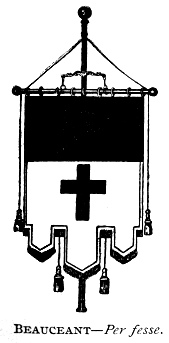
Shibboleth: A Templar Monitor, by George Cooper Connor, [1894], at sacred-texts.com

Shibboleth: A Templar Monitor, by George Cooper Connor, [1894], at sacred-texts.com
The following are the official descriptions of these Banners:
 |
and bar to be seven inches wide. On the top of the staff a gilded globe or ball, four inches in diameter, surmounted by the Patriarchal Cross, twelve inches in height. The Cross to be crimson, edged with gold."
 |
The Passion Cross is added in the drawing because the ancient Templars frequently so displayed it. And in that form they came to paint the Beauceant upon their kite-shaped Shields, as an armorial bearing.
 |
The Beauceant was the battle flag of the Templars, and the Vexillum Belli of the Order was a white banner, on which was displayed, in full size, the "Red Cross of the Order." This standard was unfurled at the headquarters of the Grand Master during time of war, but the Beauceant was always carried into the battle. This standard was known as the "Red Cross War Banner of the Order," and the Beauceant as the "Battle Flag of the Order."
UNDER THE JURISDICTION OF THE GRAND ENCAMPMENT.
Cross of Salem.—This is worn by the Grand Master as the proper emblem of his office. It is borne before the Pope in procession, and is therefore called the Pontifical Cross. When in purple enamel, and edged with gold, it is the insignia of the Grand Master and of Past Grand Masters.
Patriarchal Cross.—This Cross when in purple enamel, and edged with gold, is the insignia of all officers of the Grand Encampment below the Grand Master.
Templar Cross.—This Cross is formed of four equilateral triangles joined at the apices, and is called the Cross patée. It is the insignia of the officers of a Grand Commandery.
It is insisted upon by learned antiquarians that this is the Red Cross of the Order which the ancient Templars wore. That Cross is described as of "equal limbs, somewhat wider and somewhat concave at the ends, heraldically called patée." The "Ancient Red," here given, illustrates that Cross, and the author of this Monitor is inclined to accept it in preference to the form adopted by the Grand Encampment of the United States. This Cross was given the Templars by Pope Eugenius, and some think the Cross he gave them had its lower limb longer than the others, as in the Passion Cross.
Passion Cross.—When in red enamel, and edged with gold, the Passion Cross is the insignia of a Commander of a Commandery. This Cross appears on the Grand Standard of the Order in the United States.
Cross of Malta.—This Cross has not been adopted as insignia by the Grand Encampment. It is of white enamel, and edged with gold, and formed into eight points, as above, to represent the eight langes into which the Hospitalers (Knights of Malta) were divided.
OF A COMMANDERY OF KNIGHTS TEMPLAR.
1. A Triangle.—This is a triangular Table, of the height of thirty-two inches, and with sides not less than six feet in length. It may be covered with black velvet, and be draped with silver-fringed valance.
2. The Chamber.—This room to be entirely in black, even. to the floor.
3. The Sepulchre.—The Chamber may be utilized as the Sepulchre by suspending a curtain, with a proper painting thereon, from the ceiling, so as to conceal, at the proper time, the equipments of the Chamber proper.
4. Ascension.—Lanterns are becoming popular, but a movable Scene is much to be preferred.
5. Altar, for Prelate's use in Prelate's Hall.
6. Lectern, for Prelate's use in Asylum.
7. Robe, Mitre, Cross, and Crozier, for Prelate.
8. Pilgrim's Garb, Sandals, Staff, and Scrip.
9. Sword and Buckler.
10. Robes and Hats, for Hermits.
11. Three Tents, changeable to Huts.
12. White Robe for Penitential Year.
13. Taper for the P. P.
14. Equipments for Triangle and the Chamber.
These are necessary to the proper rendition of the ceremonies of the Order of the Temple. It is not sufficient excuse for the absence of any of them that the funds of the Commandery do not permit their purchase. A Commandery unable to provide itself with a comfortable Asylum, and the proper equipments, should not try to exist. Templarism is a luxury, and should be looked upon as an expensive one by those seeking to establish and maintain a Commandery.